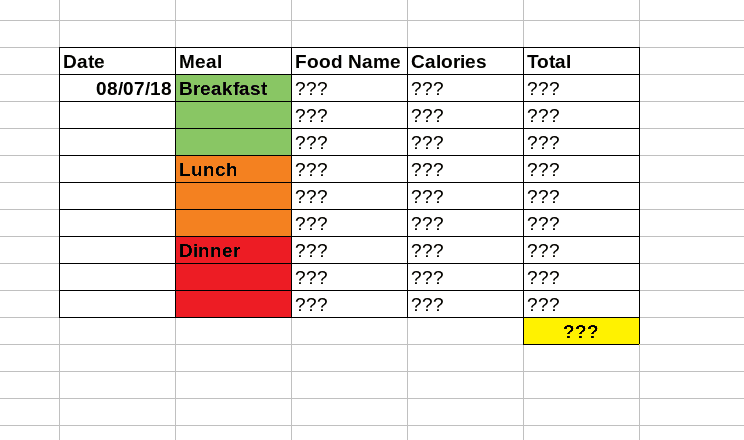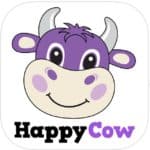5 Tech Tips That Will Make Your Vegan Life Easier
For a lot of people, going vegan can be overwhelming. For others, it is a breeze.
Whichever side of that coin you find yourself on, certain technological tips, apps, or services can be extremely helpful.
In this article, we will go over a variety of tips that can make your life as a vegan a bit easier.
Remember to share this article on social media if you enjoy it!
1.) Good ol’ Spreadsheets
Let’s start out with a classic lifestyle-tracking tip.
Now that we can easily view and edit spreadsheets wherever we are thanks to great smartphone apps such as Google Sheets, Microsoft Excel, and WPS Office, it’s more convenient than ever to track important data in our lives.
The most basic example of a useful spreadsheet for going vegan is one to track the food you eat on a daily basis.
Check out the spreadsheet below:

In that example, we measure the amount of calories in different food items we eat as the day goes on. With this sheet, you can tell what meal of the day you consume the most calories. After doing this for a week or more, we’ll have clear actionable ideas of how to improve our diet.
You could easily add more columns or substitute “Calories” for whatever metric you are most concerned about. Worried about not getting enough protein? Add a protein column. Going on a low-carb-high-fat or high-carb-low-fat diet? Feel free to track carbohydrates or fat.
Something you might be thinking is that it will be an absolute pain to have to research how many calories (or whatever your preference metrics are) are in a particular food item every time you sit down to eat.
The solution to that problem is simple. What you’re going to want to do is only jot down the “Meal” and “Food Name” column during the day. At the end of the day (or end of the week) do research on all of the food items and fill out their metric columns.
You could even include a “Notes” column with more detail about the dish you had. (Ex. “I poured around 2 tablespoons of soy sauce on the white rice.”)
Other spreadsheet ideas:
- Weekly meal plan! This will instantly make your life less overwhelming if you do a lot of home cooking.
- Creating a log of spontaneous thoughts you’re having about being vegan along your journey – this could even be done in a note-taking app
- Keeping track of your favorite recipes from around the web, including notes about recipe tweaks, and a 1 to 10 rating of how good it turned out. You could even categorize the recipes and then use spreadsheet filters to, for example, view all of your Breakfast recipes
- Vegan lifestyle & recipe blogging. I really liked Yup It’s Vegan’s article on this topic.
Spreadsheets vs. Apps for tracking data
What I love about spreadsheets is that they’re simple and versatile. Learning the basics of spreadsheets along with a few useful formulas is easy. However, you can get more complex with your sheets by introducing advanced formulas, custom scripts, or even my favorite: pivot tables.
The advantage of apps is that they can simplify things and add features that are not possible with spreadsheets. As an example, with some apps you can just scan a barcode of a food item and it will log all of the nutritional info for you.
It’s all up to you and what you feel will provide a more intuitive experience.
2.) Using Apps to Your Advantage
Vegan-related apps can be used for everything from keeping track of your diet to donating to worthy causes.
To get a comprehensive overview of the different apps that are out there, I highly recommend checking out our Ultimate Guide to Vegan Apps. Everything is neatly categorized to help you find exactly what you are looking for.
In this section I am going to cover my three favorite vegan apps and why they are so great.
Happy Cow
 Where else to start than Happy Cow? It’s got to be the most popular app marketed to vegans.
Where else to start than Happy Cow? It’s got to be the most popular app marketed to vegans.
They have an app and a web version, so it’s easy to access on both your phone and computer.
This app allows you to find vegan-friendly eateries in your local area. It supports restaurant reviews from other fellow vegans/vegetarians, easy directions on how to get to the place, and allows you to view or upload photos of the restaurant / food you order.
Vegetarian restaurants are listed, but you could easily filter for vegan eateries only. There’s even additional filters for looking for organic or raw food.
It’s also good to see that this app has great global coverage, available in over 185 countries.
gonutss Translator
 This app is also available both on the web and as an app.
This app is also available both on the web and as an app.
Gonutss’ main feature is to be able to translate non-vegan ingredients to vegan ingredients. Let’s say you’re baking a cake that requires two eggs. You could easily see different ways to substitute those eggs with vegan ingredients.
They also have their own database of vegan recipes and various calculators.
There’s one feature that would be very useful for anyone who is into fitness and transitioning to a vegan diet: The protein calculator. As an example, if you’re used to having two eggs in the morning, you can translate that to seitan and find out you need 49 grams of seitan to meet that protein amount.
CodeCheck
 There are two bar code scanners I have tried for finding out if certain products are vegan – “Is It vegan?” and CodeCheck. I have found CodeCheck to be more reliable.
There are two bar code scanners I have tried for finding out if certain products are vegan – “Is It vegan?” and CodeCheck. I have found CodeCheck to be more reliable.
With the addition of checking if a food product is vegan, there are a ton of other useful filters such as checking if it is gluten free, contains palm oil, contains allergens, or contains nasty chemicals/preservatives.
3.) Taking Notes…and Publishing Them!
Chances are that you will be doing a lot of learning as a new vegan.
Whether you are learning about nutrition, animal welfare, losing weight, or fitness, it helps to take notes. You’ve all heard it before but taking notes improves the chances of you being able to remember certain pieces of information. Not only that, but you’ll be able to go back to the information later and review what you have learned, saying “Oh yeah, I completely forgot about that!”
There will be topics you come across where you really have to info-dive. Why is this though? You’re not a pioneer and there have many, many people that have researched the same topics.
You can save another person the same effort you went through by publishing your notes online.
This is easy nowadays. You don’t have to be a tech wizard to create a website. You don’t even have to pay to own a site if you don’t want to as their are plenty of free platforms such as WordPress, which offers completely free blog hosting for you to start out with.
There are other solutions as well. Medium makes it just as easy as any other social network to post content. I’ve also recently come across write.as which can allow you to write anonymously.
Here is an example over at KeepItVegan of how I published notes:
How to tell if Tempeh has gone bad. I just had no idea at what point tempeh goes bad. Surprisingly there was little information on this topic. It took much research, but I figured out the answer to my question and published the notes. Now that article helps people who were in the same position as me identify if their tempeh has gone bad or not.
Here’s one more example on a more technical topic. B12, it’s something us vegans need to pay extra attention to. But what is it, why is it important, and what type of supplements should I get if I even need it?
There’s a lot of articles on the topic of B12, but I was having trouble finding past a surface-level knowledge. After a lot of research, we created our big guide to B12.
4.) Get Charitable with Micro-Donations
Thanks to services like Patreon it is incredibly easy to support content creators, activists, and all-around good causes, such as animal sanctuaries.
You can donate as little as $1 a month. That might not sound like a lot, but when you get thousands of people around the world making that same $1 a month donation (or more!) people are able to pursue their passions and causes without worrying about being strapped for cash.
Some Patreon pages I recommend checking out are…
- BiteSizedVegan, creating high-quality educational videos on veganism.
- Joey Carbstrong, an incredibly hard working vegan activist.
- Barn Sanctuary, animal sanctuary.
- Lemon Ranch, animal sanctuary.
- Juliana’s Animal Sanctuary, animal sanctuary in Columbia.
5.) Use Pinterest as your own Recipe Vault
Pinterest makes it easy to save images and links to various boards you create in a very visual manner.
It could be used for many purposes but in this tip we’ll focus on its use as a recipe vault.
You can create boards focused on different themes. Take the below examples as different category ideas.
- Easy Breakfast Recipes
- Easy Lunch Recipes
- Easy Dinner Recipes
- Health Snack Recipes
- Dips & Superbowl Snacks
- AMAZING Breakfast Recipes
- AMAZING Lunch Recipes
- AMAZING Dinner Recipes
The next step is to download the Pinterest Save extension for Chrome.
Now, whenever you find a cool recipe on the web, you just have to click that little Pinterest extension icon and save it to your desired board.
Final Notes
Thanks for reading!
If you’re brand new to veganism, don’t forget to check out our Ultimate Guide to Veganism.
In what ways do you use technology to your advantage as a vegan? Comment below.
Leave a Comment